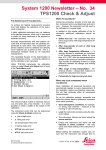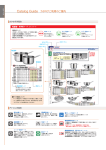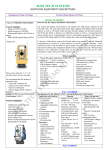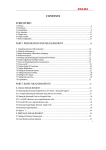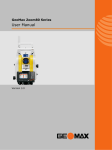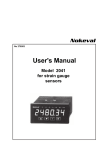Download Sqcp K_ls_j RA&P`//.
Transcript
User Manual TC(R)110 English Version 2.0 Electronical Total Station Congratulations on your purchase of a new Leica Geosystems Total Station. This manual contains important safety directions (refer to chapter "Safety directions") as well as instructions for setting up the product and operating it. Read carefully through the User Manual before you switch on the product. 2 Electronical Total Station Product Identification The type and the serial number of your instrument are indicated on the label inside the battery compartment. Write the type and serial number of your instrument in the space provided below, and always quote this information when you need to contact your agency or service workshop. Type: Serial no.: 3 Product Identification Symbols Used in this Manual The symbols used in this User Manual have the following meanings: DANGER: Indicates an imminently hazardous situation which, if not avoided, will result in death or serious injury. WARNING: Indicates a potentially hazardous situation or an unintended use which, if not avoided, could result in death or serious injury. CAUTION: Indicates a potentially hazardous situation or an unintended use which, if not avoided, may result in minor or moderate injury and / or appreciable material, financial and environmental damage. Important paragraphs which must be adhered to in practice as they enable the product to be used in a technically correct and efficient manner. 4 Symbols Used in this Manual Contents - Overview Introduction ......................................................................... 9 Operating concept, Keyboard ......................................... 13 Measuring preparation ..................................................... 22 Measuring .......................................................................... 34 Programs ........................................................................... 42 Menu ................................................................................... 44 Checking and Adjusting .................................................. 56 Care and Storage .............................................................. 67 Messages and Warnings ................................................. 70 Accessories ....................................................................... 73 Safety Directions .............................................................. 74 Technical Data .................................................................. 94 Index ................................................................................... 99 5 Contents - Overview Contents Area of Applicability .................................... 8 Accurate Levelling-Up with Electronic Level ........................................ Laser Intensity .......................................... Hints for Positioning ................................. Centring with Shifting Tribrach ................. Introduction ................................................ 9 Special Features ......................................... 9 Important Components ............................. 10 Technical Terms and Abbreviations .......... 11 Operating concept, Keyboard ................ 13 Focus, Buttons .......................................... Symbols .................................................... Menu tree .................................................. User Entries .............................................. 31 32 32 33 Measuring ................................................. 34 Displayed Data ......................................... Distance measurement ............................ Coordinate measurement ......................... EDM Change (TCR only) ......................... Laserpointer (TCR only) ........................... Angle measurement ................................. 15 16 17 20 Measuring preparation ............................ 22 34 35 38 39 39 40 Set Hz-angle ............................................ 40 Set Hz-angle direction ............................. 40 Unpacking ................................................. 22 Batteries .................................................... 23 Battery Charger ........................................ 24 V-angle setting .......................................... 41 Battery Charger GKL111 ......................... 24 Programs .................................................. 42 Inserting / Replacing Battery ................... 26 Tie Distance .............................................. 42 External power supply for total station ..... 28 Construction .............................................. 43 Setting Up the Tripod ................................ 29 As built check .......................................... 43 Centring with Laser Plummet, Coarse Level-Up ....................................... 30 Menu .......................................................... 44 Settings ..................................................... 44 6 Contents Contents, continued System Settings ....................................... EDM Settings ........................................... Angle Settings .......................................... Unit Settings ............................................ 45 48 50 51 Inside Vehicle ........................................... 68 Shipping ................................................... 68 Storage ..................................................... 68 Cleaning ................................................... 69 System Information ................................. 52 Communication Parameters ..................... 55 Messages and Warnings ........................ 70 Checking and Adjusting ......................... 56 Accessories .............................................. 73 Electronically ............................................ 56 Safety Directions ..................................... 74 Line-Of-Sight Error (Hz-Collim.) .............. Vertical Index Error (V-Index) .................. Determining Instrument Errors ............... Determining The Line-Of-Sight Error (c) Determining V-Index ................................ 56 57 57 59 60 Tripod ....................................................... Circular Level ........................................... Circular Level on the Tribrach ................. Laser Plummet ........................................ Reflectorless EDM ................................... 62 62 62 63 64 Intended Use of Instrument ...................... 74 Permitted Uses ........................................ 74 Adverse Uses .......................................... 74 Limits of Use ............................................. 75 Responsibilities ......................................... 76 Laser Classification .................................. 83 Mechanical ................................................ 62 Integrated EDM (Infrared Laser) ............ 83 Integrated EDM (Visible Laser) .............. 85 Laser Plummet ........................................ 87 Electromagnetic Compatibility (EMC) ...... 90 FCC Statement (Applicable in U.S.) ........ 92 Care and Storage ..................................... 67 Transport ................................................... 67 Technical Data ......................................... 94 In the Field ............................................... 67 Index .......................................................... 99 7 Contents Area of Applicability This User Manual is valid for all instruments in the TPS110 Series. TC Instruments are equipped with an invisible infrared EDM. The TCR Instruments are also equipped with a visible red laser for reflectorless measuring and a serial interface. Sections only valid for TCR instruments are marked accordingly. 8 Area of Applicability Introduction Special Features The Leica Geosystems TC(R)110 is a high-quality electronic total station designed for the construction site. Its innovative technology makes the daily surveying jobs easier. • Easy and quickly to learn ! The instrument is ideally suited for simple construction surveys. • Measurements without reflector with the integrated visible laser beam (TCR instruments). • Interactive keys; with large and clear LCD. • Small, light-weight and easyto-use. The operation of the instrument's functions can be learned easily in a short space of time. • Continuous drives for horizontal and vertical angles (tangent screws). • Laser plummet and electronic level for quick and easy set up. TPS100z01 • Variable battery concept. 9 Introduction 1 2 3 4 5 6 7 TPS100z02 Important Components 8 1 2 3 4 5 6 7 8 9 10 11 12 9 10 11 12 13 14 15 10 16 17 13 14 15 16 17 Alignment sight Vertical drive Battery GEB111 Battery spacer for GEB111 Battery holder for GEB111/ GEB121/GAD39 Eyepiece Telescope focusing ring Detachable carrying handle with mounting screws Serial interface RS232 (TCR110 ) Foot screws Objective with integrated Electro-optic Distance Meter (EDM) Battery adapter GAD39 for 6 single cells (optional) Battery GEB121 (optional) Display Keypad Circular level Horizontal drive Introduction Technical Terms and Abbreviations ZA = Line of sight / collimation axis Telescope axis = line from the reticle to the centre of the objective. SA SA V ZA ZA SA = Standing axis Vertical rotation axis of the total station. KA KA = Tilting axis Horizontal rotation axis of the telescope (Trunion axis). VK V = Vertical angle / zenith angle KA VK = Vertical circle With graduated scale for reading the V-angle. Hz HK SA SA 11 TPS100z24 Hz = Horizontal angle HK = Horizontal circle With graduated scale for reading the Hz-angle. Introduction TPS100z40 TPS100z39 TPS100z37 TPS100z38 Technical Terms and Abbreviations, continued Plumb line / Compensator Standing axis Inclination Zenith Reticle Direction of gravity. The compensator defines the plumb line within the instrument. Angle between plumb line and standing axis. Point on the plumb line above the observer. Glass plate within the telescope engraved with the cross hair lines. 12 Introduction Operating concept, Keyboard Function keys Display dependent keys: Used either as fixed keys or as buttons. Sets Hz-angle to 0 Measures distance and angles Switches electronic level and laser plummet ON/OFF Fixed keys ON/OFF keys Sets the "0"-orientation of the V-angle Switches instrument ON Sets Hz-angle direction Changes display (scroll) Switches instrument OFF by pressing both keys simultaneously 13 Operating concept, Keyboard Operating concept, Keyboard, continued Shift key: Switches to the second key level ( , , , , + , Calls to the menu functions (Instrument settings, System information and calibration) ). Key combinations + Change between the two EDM types IR (infrared) and RL (reflectorless). (TCR only) + Holds Hz-angle + + Switches visible laser beam ON/OFF (TCR only). Calls the inputs display for reflector and instrument height) + Switches the display illumination ON/ OFF and activates the display heating (if the instrument temperature is less than -5°C). 14 Operating concept, Keyboard Focus, Buttons SYSTEM SETTINGS 1/3 Beep : Normal Sector Beep : On Contrast : 60% Reticle : Low Displ.Heater : Off Auto OFF :Disable [OK] On The focus indicates the currently processed field.The focus is controlled with buttons. Selects a setting or starts the edit mode (if the field allows user entries). Refer to chapter "User Entries" [OK] Buttons are functions in the bottom line of the display. A button is always assigned to a function key directly below it ( , , ). Important buttons Moves the focus downwards. Reaching the bottom field the focus jumps to the top field (wrap around). 15 [OK] Confirms settings; starts menu command [EXIT] Leaves the display [MEAS] Button for measurements in the applications Buttons and the focus can be found in the menu and the inputs display. Find more and detailed information about buttons and focus in the relevant sections. Operating concept, Keyboard Symbols 1/3, 2/3, 3/3 1/2, 2/2 Indicates that several pages are available which can be selected with . The last page is followed by the first. .. /.. Current page / total number of pages I, II Indicates telescope face I or II Indicates that Hz is set to "left side angle measurement" (anticlockwise). Compensator status Compensator switched on (2 axes). Compensator switched off. Status symbol "Battery capacity" The battery symbol indicates the level of the remaining battery capacity (75% full shown in the example). Status symbol "EDM type" IR RL Infrared EDM (invisible) for measuring with prisms and reflective targets. Reflectorless EDM (visible) for measuring without prisms. A double arrow indicates choice fields. The desired parameter can be selected using the button. Selection fields can be left with the button. Status Symbol "Shift" was pressed. 16 Operating concept, Keyboard Menu tree ( [OK] ) SYSTEM Beep Sector Beep Contrast Reticle Displ.Heater Auto OFF SYSTEM SETTINGS Set beep (Off/Normal/Loud) Set sector beep (Off/On) Set display contrast (0%-100%) Reticle illumination (Low/Medium/High) Display heater (On/Off) Auto OFF (Enable/Disable/Sleep) EDM Laserpointer EDM Mode Prism Type Prism Const. EDM SETTINGS Visible laser beam On/Off Select EDM mode (IR-Standard/IR-Track/IR-Tape/RL-Standard/RL-Track) Select prism type (Mini/Round/Tape/RL/User) Entry of user specific prism constant (User) ANGLE / UNITS Tilt Corr. Hz-Collim. Angle Res. Angle Distance ANGLE / UNIT SETTINGS Tilt compensation On/Off Hz-collimation (line of sight error) On/Off Select angle resolution Select angle unit (° ' '' / gon / 360° decimal / mil) Select distance unit (meter / US feet / INT feet / US feet-inch-1/8 inch) 17 Operating concept, Keyboard Menu tree, continued [OK] COMMUNICATION Baudrate Databits Parity Endmark Stopbits COMMUNICATION SETTINGS Data Transfer Speed 2400 / 4800 / 9600 / 19200 bits/second 7 or 8 Even / Odd / None CR / CRLF 1 [OK] TIE DISTANCE APPLICATION [OK] CONSTRUCTION APPLICATION [OK] SYSTEM INFO 1 Tilt Corr. Hz-Collim. Hz-Direction Battery Instr. Temp. Displ.Heater SYSTEM INFORMATION 1 (DISPLAY ONLY) Tilt compensation Hz-Collimation (line of sight error) Hz-angle direction Battery capacity Instrument temperature Display heater 18 Operating concept, Keyboard Menu tree, continued [OK] SYSTEM INFO 2 SW-Versions: Op-System Appl.-SW Layout SYSTEM INFORMATION 2 (DISPLAY ONLY) CALIBRATION Calibration data Hz-Coll (c) V-Index (i) Determining instrument errors Indication of calibration data Hz-Collimation (c) V-Index (i) Operating System Application software User displays [OK] Hz-Collimation Determining Hz-Collimation [OK] V-Index Determining V-Index 19 Operating concept, Keyboard User Entries User entry fields are characterized by the focus. Input fields • Input fields: Enter/Edit data (e.g. reflector height) Example: Inputs display • Choice fields: Selection out of a predefined choice list (e.g. units). A double arrow indicates a choice field. Opens the Inputs display Character set The vertical character bar contains the following characters: "+" (ASCII 43) "-" (ASCII 45) "0-9" (ASCII 48 - 57) ( 3. Select the desired character. + ) 1. Position focus on desired input field. 2. Start Edit mode: The vertical character bar is positioned left justified. INPUTS+ Reflector height 0 hr : 1.500 m 2 Instrument height 3 hi : 1.500 m 4 [OK] 5 20 4. Confirm selected character: The vertical character bar moves to right. 5. Repeat steps 3 and 4 if necessary. [OK] 6. Confirm input: The vertical character bar is being closed, the focus positions on the next input field. [OK] 7. Leaves the display. Operating concept, Keyboard User Entries, continued Choice fields 1. Position focus on desired choice field. Example: System settings 2. Select setting. ( + ) Opens the MENU display [OK] Selects the configuration 3. Confirm setting: The focus positions on the next choice field. [OK] 4. Leaves the display. SYSTEM SETTINGS 1/3 Beep : Normal Sector Beep : On Contrast : 60% Reticle : Low Displ.Heater : Off Auto OFF :Disable [OK] Change display 21 Operating concept, Keyboard Measuring preparation Unpacking from transport case and check for TPS100z31 Remove TC(R)110 completeness: 1 2 3 4 10 5 6 7 11 Ku om dlk o olm kd dk ko kjo ko kd ojo ng jkm iük 9 itu 00 dk lkd nle rza TP S1lko ok klk öm lko 12 k 13 8 14 9 15 22 1 Data cable* 2 Diagonal eyepiece or eyepiece for steep angles* 3 Counterweight for eyepiece for steep angles* 4 Removable tribrach GDF101 / shiftable tribrach GUS75* 5 Battery charger and accessories* 6 Allen key (2x) Adjusting pins (2x) 7 Spare battery GEB111* 8 Sun filter / plug adaptor tribrach* 9 Mains adapter for battery charger* 10 Mini prism rod* 11 Total station (incl. battery) 12 Mini prism + holder* 13 User Manual / Short Instructions / Mini target plate (only for TCR instruments) 14 Protective cover / Lens hood 15 Tip for mini prism* *) optional Measuring preparation TPS100z93 Batteries GEB121 Your Leica Geosystems instrument is operated with rechargable plug-in batteries. The Basic battery (GEB111) or the Pro battery (GEB121) is recommended for TPS110 Series instruments. As an option, six individual cells can be used with the appropriate battery adapter GAD39. GEB111 Individual cells in the battery adapter GAD39 The advantage of individual cells is the low self-discharge rate - even over longer periods of time. Only use batteries, battery chargers and accessories recommended by Leica Geosystems. Six individual cells (1.5 V each) produce a voltage of 9 Volts. The battery indicator in the display is designed for a voltage of 6 Volts (GEB111/GEB121). For this reason the charge state of individual cells is not indicated correctly. The battery adapter with individual cells should therefore be used as a backup. 23 Measuring preparation WARNING: Use a battery charger in a dry room only, never outdoors. Charge the batteries under ambient temperatures of 0°C to +35°C (32°F to 95°F). We recommend a temperature of 0°C to +20°C (32°F to 68°F) for storing the batteries. In order to fully extend battery capacity it is absolutely necessary to carry out 3 to 5 complete charging/ discharging cycles with the new GEB111/GEB121 batteries. Vehicle connection cable Mains connection cable Battery charger GKL111 Using the Basic battery charger GLK111 one Basic / Pro battery can be charged. Charging can be carried out via a mains socket using the power supply unit or via the vehicle connection cable inside vehicles (12V). 24 TPS100z74 The battery charger GKL111 is used to charge the batteries. Please refer to the battery charger user manual for more information. Battery Charger GKL111 TPS100z73 Battery Charger Connect battery charger GKL111 to mains or inside the vehicle. Insert battery GEB111/GEB121 into the charger so that the metal contacts of the charger and of the battery connect and the battery is locked in place. The continuously lit green lamp indicates the charging process. Measuring preparation As soon as the green lamp is flashing the battery is charged and can be removed from the charger. Charging time is 1 to 2 hours. Insert charged battery into the battery holder of your instrument. Pay attention to the correct polarity (corresponding to the diagram in the battery cover). TPS100z76 TPS100z75 Battery Charger GKL111, continued Find more information in section "Inserting / Replacing Battery" or the instruction leaflet for the charger GKL111. Slide battery holder with inserted battery into the instrument. Now the instrument is ready for measuring and can be switched on. 25 Measuring preparation 1. Remove battery holder. 2. Remove battery and replace. 26 TPS100z05 TPS100z04 TPS100z03 Inserting / Replacing Battery 3. Insert battery into battery holder. Measuring preparation Inserting / Replacing Battery, continued Insert battery correctly (note pole markings on the inside of the battery cover). Check and insert battery holder true to side into the housing. For type of battery see section "Technical Data". TPS100z06 • If the battery GEB121 or the battery adapter GAD39 for six individual cells is used, the spacer for the GEB111 must be removed from the battery holder prior to inserting the battery. 4. Insert battery holder into instrument. 27 Measuring preparation To meet the conditions stipulated for electromagnetic acceptability when powering the TCR110 from an external source, the supply cable used must be equipped with a ferrite core. TPS100z98 The Lemo plug with the ferrite core always has to be attached at the instrument side. The cables supplied along with your instrument include a ferrite core as standard. If you are using older cables without ferrite core, it's necessary to attach ferrite cores to the cable. If you need additional ferrite cores, please contact your local Leica Geosystems agency. The spare-part number of the ferrite core is 703 707. 28 TPS100z99 External power supply for total station For assembling open up one ferrite core and clip it around the supply cable, about 2cm away from the Lemo plug, before using the supply cable for the first time together with a TCR110 instrument. Measuring preparation When setting up the tripod pay attention to a horizontal position of the tripod plate. 1. Loosen the clamping screws on the tripod legs, pull out to the required length and tighten the screws. 2. In order to guarantee a firm foothold sufficiently press the tripod legs into the ground. Careful handling of tripod • • Heavy inclinations of the tripod plate must be corrected with the tribrach footscrews. 29 TPS100z58 TPS100z57 TPS100z33 TPS100z32 TPS100z19 Setting Up the Tripod • Check all screws and bolts for correct fit. During transport always use the cover supplied. Use the tripod only for surveying tasks. Measuring preparation Centring with Laser Plummet, Coarse Level-Up 4. 1. 8. 5. 5. 5. 7. 5. 6. TPS100z08 TPS100z07 1. Place the instrument onto the tripod head. Tighten central fixing screw of tripod slightly. 2. Turn footscrews of tribrach into its centre position. 3. Switch on the instrument with 6. 4. Switch on laser plummet with . The electronic level appears in the display. 5. Position tripod legs so that the laser beam is aimed to the ground point. 6. Firmly press in tripod legs. . 30 8. 8. 6. 7. 8. TPS100z09 3. 1. 7. Turn the footscrews of the tribrach to centre the laser beam exactly over the ground point. 8. Move the tripod legs to centre the circular level. The instrument is now roughly levelled-up. Measuring preparation Accurate Levelling-Up with Electronic Level 2. Center the electronic level by turning the footscrews. If the electronic level is centered the instrument is levelled-up. 20" 20" TPS100z10 1. Switch on electronic level with . In the case of insuffient levelling-up an inclined level symbol appears. 3. Check centring with the laser plummet and re-centre if necessary. 4. Switch off the electronic level and the laser plummet with [OK]. 31 Measuring preparation Laser Intensity Hints for Positioning External influences and the surface conditions may require the adjustment of the intensity of the laser. The intensity of the laser plummet can be adjusted in 25% steps as required. TPS100z35 Changing the laser intensity The indicated laser intensity is set, and the function terminated, with the [OK] button . Laser plummet and electronic level are activated together with . Positioning over pipes or depressions Min. 50% In some circumstances, the laser spot is not visible (e.g. over pipes). In this case, the laser spot can be made visible by placing a sheet of transparent material over the end of the pipe. Max 32 Measuring preparation TPS100z23 Centring with Shifting Tribrach If the instrument is equipped with a shifting tribrach it can be aligned to the ground point by slight shifting. 1. Loosen screw. 2. Shift instrument. 3. Fix instrument by turning screw. 33 Measuring preparation Measuring Displayed Data After switching on In measuring mode all keys are active. and setting up correctly, (refer to chapter "Measuring preparation") the total station is immediately ready for measuring. Explanation of displayed data E, N, H Example of a possible measuring display: ANGLE & DISTANCE : : : : 23°26'08" 61°02'57" ---.--- m IR ---.--- m V hr Hz hi Changes to displays with additional data. TPS100z59 Hz V 1/3 E 0, N 0, H 0 34 Hz Horizontal angle V Vertical angle Slope distance Horizontal distance Height difference E Easting of target point N Northing of target point H Height of target point hr Reflector height above ground hi Instrument height above ground E0 Station coordinate (Easting) N0 Station coordinate (Northing) H0 Station height Measuring Distance measurement Pointing Distance measurement Tracking mode Centre cross hairs of the telescope to the middle of the prism. Triggers a distance measurement and shows this on the display. The displayed distance remains valid until it is replaced by a new distance measurement. Angles are displayed independently of the distance measurement. If the tracking mode is active (refer to chapter "EDM Settings") the distance is triggered continuously after . Stops the tracking mode. TPS100z100 Changes to displays with additional data (e.g. Height difference or Coordinates) 35 Measuring Distance measurement, continued Measurements to strongly reflecting targets such as to traffic lights in infrared mode without prism should be avoided. The measured distances may be wrong or inaccurate. For applications without reflector, the TCR-version also use a visible red laser beam When a distance measurement is triggered, the EDM measures to the object which is in the beam path at that moment. If e.g. people, cars, animals, swaying branches, etc. cross the laser beam while a measurement is being taken, a fraction of the laser beam is reflected and may lead to incorrect distance values. Avoid interrupting the measuring beam while taking reflectorless measurements or measurements using reflective foils. Measurements to prism reflectors are only critical if an object crosses the measuring beam at a distance of 0 to 30m 36 and the distance to be measured is more than 300m. In practice, because the measuring time is very short, the user can always find a way of avoiding these critical situations. Incorrect result Correct result 1100z46 In all versions, the distance can be determined by using an invisible infrared beam which emerges coaxially from the telescope objective. which emerges in the same manner. 1100z47 A laser distancer (EDM) is incorporated into the instruments of the TPS110 series. Measuring Distance measurement, continued Reflectorless Be sure that the laser beam is not reflected by anything close to the line of sight (e.g. highly reflective objects). When a distance measurement is triggered, the EDM measures to the object which is in the beam path at that moment. In case of temporary obstruction (e.g. a passing vehicle, heavy rain, fog or snow) the EDM may measure to the obstruction. When measuring longer distances, any divergence of the red laser beam from the line of sight might lead to less accurate measurements. This is because the laser beam might not be reflected from the point at which the crosshairs are pointing. Therefore, it is recommended to verify that the R-laser is well collimated with the telescope line of sight (refer to the chapter "Checking and adjusting"). Do not measure with two instruments to the same target simultaneously. Red laser to prisms WARNING: Due to laser safety regulations and measuring accuracy, using the visible red laser (RL) is only allowed to prisms that are more than 1000 m (3300 ft) away. 37 Accurate measurements to prisms should be made with the standard program (Infrared mode). Red laser to reflector tape The visible red laser beam can be used to measure to reflective foils, also. To guarantee the accuracy the red laser beam must be perpendicular to the reflector tape and it must be well adjusted (refer to the chapter "Checking and adjusting"). Make sure the additive constant belongs to the selected target (reflector). Measuring 0" N 0'0 H 0°0 The coordinates of the target point (E, N) always refer to the instrument station as origin of the coordinate system. The northing is defined through the 0° horizontal angle, the easting through the 90° horizontal angle. TPS100z28 Coordinate measurement E E 0 , N 0, H 0 38 Measuring EDM Change (TCR only) ( + ) Change between the two EDM types IR (Infrared) and RL (Reflectorless) as listed below. New setting is displayed for about one second and then set. Laserpointer (TCR only) IR: RL: Infrared: invisible, Distance measurements with prisms and tapes. Visible laser: Distance measurements without prisms up to 80m. Find more information in section "EDM Settings". ( + ) Switches on or off the visible laser beam for illuminating the target point. The new setting is displayed for approx. one second and then set. IR-Standard RL-Standard IR-Track RL-Track IR-Tape RL-Standard 39 Measuring Angle measurement Set Hz-angle Set Hz-angle direction Set Hz-angle to 0°00'00" Set any Hz-angle Switch between "Right angle measurement" (= clockwise) and "Left angle measurement" (= anticlockwise). 1. Aim on orientation point. 2. The following confirmation message is shown: 1. Turn telescope to the desired Hzangle. 2. Hold indicated Hzangle. The Hz-angle in the display starts flashing. Set Hz = 0 ? ANGLE & DISTANCE [YES] [YES] [NO] [NO] 3a: Set Hz-angle to 0. Back to measuring mode automatically. 3b: Back to measuring mode automatically without change. Hz V : : Indicates that Hz is set to "left angle measurement" (anticlockwise). 1/3 23°26'08" 61°02'57" 3. Aim on orientation point. 4. 5. Set Hz-angle. The Hz-angle stops flashing. 40 Measuring V-angle setting Slope % --.--% +300% 4' Horizontal plane +100% 71°3 Zenith 4 5° +18% 20° -5 TPS100z29 is shown on the right of the V-angle 41 0 go 0° ±V n -100% n is shown on the right of the V-angle V-angles above the horizontal plane are indicated as positive values and below the horizontal plane as negative values. 360s gon 5 go TPS100z28 -79. The V-angle increases from 0° 360° (0 - 400 gon). --.--% TPS100z87 Sets the "0"-orientation of the V-angle -300% 100% correspond to an angle of 45° (50 gon, 800 mil). The % value increases rapidly. "--.--%" appears on the display above 300%. Measuring Programs Procedure: 1. Determine first target point. [MEAS] Starts measurement to the target point. Tie Distance The application Tie Distance computes slope distance, horizontal distance, height difference and azimuth of two measured target points. [NewPt1] [NextPt2] TPS100z95 Polygonal Method: 2. Determine second target point. Proceed as with first target point. An additional missing line is computed. Program starts again (at point 1). Point 2 is set as starting point of a new missing line. New point (Pt 2) must be measured. 3. Result is displayed. Brg Azimuth between point1 and point2. S dist Slope distance between point1 and point2. H dist Horizontal distance between point1 and point2. H diff Height difference between point1 and point2. 42 Menu As built check This application allows to define a construction site by combining set-up of the instrument along a construction line and measuring in relation to the line. This dialog shows you the !Line, !Offset and !Height of a measured point in relation to the line. Procedure: Line Start point [MEAS] Measures to point [COORD]* Entry of point coordinates Second Line point [MEAS] Measures to point [COORD]* Entry of point coordinates *) Visible if [SHIFT] is pressed NORTH is positive: Measured point is in direction from line start - to line end point. The height of the line start point is always used as the reference height! TPS100z96 Construction EAST is positive: Measured point is right of line. !Height is positive: Measured point height is above line start point's height. In case, you have entered coordinates by [COORD] and measured to known points a plausibility check informs you about the calculated line length, the actual length and the difference. 43 1) 2) 3) 4) Line Start point Second Line point North East Menu Menu ( Settings + ) Opens the menu functions. MENU SETTINGS SYSTEM INFORMATION CALIBRATION [EXIT] The display contents, particularly lines, contained in this description can vary in local versions of the software. The function of the display is however identical. This menu allows user specific settings in order to adapt the instrument to their own requirements. The settings are subdivided thematically into three displays: • System settings • EDM settings • Angle / Units [OK] 1. Opens the menu [EXIT] [OK] Leaves the menu. Back to measuring mode. Selects the desired menu command. Starts the menu command. [OK] 44 functions. 2. Starts the "SETTINGS" 3. Changes display Menu Settings, continued System Settings All parameter section fields are available to the user. Beep Sector Beep The beep is an acoustic signal after each key stroke. Off On 1. Position focus on desired choice field. 2. Select setting. 3. Confirm setting: The focus positions on the next choice field. [OK] 4. Leaves the display. Back to measuring mode. Off Normal Loud Beep switched off Beep switched on Increased volume Sector beep switched off. Sector beep sounds at right angles (0°, 90°, 180°, 270° or 0, 100, 200, 300 gon) Example Sector Beep: From 95.0 to 99.5 gon (or from 105.0 to 100.5 gon) a "Fast beep" sounds whilst from 99.5 to 99.995 gon (or from 100.5 to 100.005 gon) a "Permanent beep" sounds. 45 Menu 90° 1 3° 3° 2 1 90° 2 1 90° 1 No beep 2 Fast beep (interrupted) 3 Permanent beep Display contrast 10% Setting the display contrast in 10% steps; The readability of LCDs is influenced by external conditions (temperature, lighting) and by the reading angle (see figure). The display contrast can be adapted step by step until the optimum readability is achieved. 46 TPS100z30 TPS100z27 System Settings, continued Menu System Settings, continued Reticle illumination Display heater Auto OFF The reticle illumination is only switched on if the display illumination is on. Off Disable Function is deactivated and the instrument is permanently operating. The battery will not last for as long. Enable The instrument is switched off after 15 minutes without any action (= no key pressed; V and Hz angle deviation ≤ ±3' / ±600cc). Sleep The instrument switches to economy mode after 15 minutes. Instrument is recovered by [OK]. ( + Low Medium High ). reticle illumination dimmed average brightness strong illumination On Display heater is switched off. Display heater is automatically activated when the display illumination is on and the instrument temperature is < -5°C. 47 Menu EDM Settings EDM SETTINGS 2/3 Laserpointer: Off EDM Mode :IR-Track Prisme Type : Mini Prism Const.: 18 mm [OK] Laserpointer Off On Visible laser beam is switched off. Visible laser beam for defining the target point is switched on. EDM Mode The EDM Mode is selected according to the desired distance measurement accuracy and the prism type that is being used. Depending on selected measuring mode the selection prism types are different. With TCR instruments settings for measurements with visible EDM mode (RL = reflectorless) are available in addition to the settings for measurement with invisible EDM mode (IR = infrared) (see following). RL-Standard Distance measurements without prisms with a target distance up to 80 m. (5 mm + 3 ppm)* RL-Track Continuous distance measurement without prisms with a target distance up to 80 m. (5 mm + 3 ppm)* With the RL-EDM each object in the beam is measured (possibly branches, cars, etc.).. * accuracy ppm = mm / km 48 Menu EDM Settings, continued IR-Standard For distance measurements with prisms with a target distance up to 500 m. (5 mm + 3 ppm)* Prism type IR-Track Continuous distance measurement with prisms up to 500 m. (5 mm + 3 ppm)* Round prism GPR111 IR-Tape Distance measurement using Retro targets with a target distance up to 250 m. (5 mm + 3 ppm)* Miniprism GMP111 +17.5 Reflective targets +34.4 * accuracy ppm = mm / km Leica Geosystems Prisms (Basic Series) Constants [mm] 0.0 USER is set at "Prismconst" (Example next page) RL (Reflectorless) 49 -+34.4 Menu EDM Settings, continued Angle Settings Prism constant Tilt Correction Entry of a user specific prism constant (refer to chapter "User Entries"). Input can only be made in [mm]. Off Formula: Prism constant to be entered = -mm + 34.4 On Compensator switched off. Compensator (2 axes) switched on. V-angles relate to plumb line and the Hz-angles are corrected for the tilt of the standing axis. If the instrument is used on an unstable base (e.g. shaking platform, ship, etc.) the compensator should be switched off. This avoids the compensator drifting out of its measuring range and interupting the measuring process by indicating an error. Example: The compensator setting remains active even after the instrument is switched off. Non-Leica Geosystems prism constant = 14 mm =>Prism constant to be entered = -14 + 34.4 = 20.4 Limit value: -999 mm to +999 mm 50 Menu Angle Settings, continued Unit Settings Hz collimation Resolution Angle Off The displayed angle format can be selected in three steps. • ° ' " (degree sexagesimal) possible angle values: 0° to 359°59'59'' • For 360°'": 0° 00' 01" / 0° 00' 05" / 0° 00' 10" • dec. deg (degree decimal) possible angle values: 0° to 359.999° • For 360°: 0.001° / 0.005° / 0.01° • gon possible angle values: 0 gon to 399.999 gon • For gon: 0.001 gon / 0.005 gon / 0.01 gon • mil possible angle values: 0 to 6399.99mil • For mil: 0.01 mil / 0.05 mil / 0.1 mil The setting of the angle units can be changed at any time. The actual displayed values are converted according to the selected unit. On Hz-collimation is switched off. Hz-collimation is switched on. If option "Hz-collimation ON" is active, each measured Hz-angle is corrected relative to the Vangle. For normal operation the Hzcollimation remains switched on. Find more information about the Hz-collimation in section "Determining instrument errors". 51 Menu Unit Settings, continued System Information Distance Useful information which can be called via menu. These are only indications of actual setting and cannot be changed here. All changes to settings must be carried out in menu "SETTINGS". meter US-ft INT-ft ft-in1/8 Meter US feet International feet US feet / inch / 1/8 inch 52 ( [OK] + ) 1. Open the menu functions. 2. Select the menu command "SYSTEM INFORMATION". 3. Start "SYSTEM INFORMATION" 4. Change display Menu System Information, continued Tilt Correction Hz collimation Battery Display of current compensator setting. Off Tilt compensation switched off. On Compensator (2 axes) switched on. V-angles relate to plumb line and the Hz-angles are corrected for the tilt of the standing axis. Off Remaining battery power (e.g. 40%). On Hz-collimation is switched off. Hz-collimation is switched on. Instrument temperature Hz-angle direction Right Hz set to "Right angle measurement" (= clockwise). Left Hz set to "Left angle measurement" (= anticlockwise). Measured instrument temperature (always in °C). "Left angle measurements" are only shown in the display. 53 Menu System Information, continued Display heater (On/Off) Software versions Off The instrument software is composed of different software packages. Depending on the package different versions are possible. On Display heater is switched off. The display heater is automatically activated when the display illumination is on and the instrument temperature is < -5°C. When the temperature increases again, the heating is automatically switched off. The display contents, particularly lines, contained in this description can vary in local versions of the software. Op-System: Operating System Appl.-SW: Applications, functions and menu Layout: User displays (Language) 54 Menu Communication Parameters Leica Standard setting 19200 Baud, 8 Databit, No Parity, 1 Stopbit, CR/LF Baudrate Data transfer speed 2400, 4800, 9600, 19200 [bits / second] Databits 7 Data transfer is realized with 7 databits. Is set automatically if parity is "Even" or "Odd". 8 Data transfer is realized with 8 databits. Is set automatically if parity is "None". Parity Even Odd None Even parity Odd parity No parity (if data bit is set to 8) Endmark CRLF Carriage return; line feed CR Carriage return Mask 1/2 Select GSI output mask. Mask1: PtID, Hz, V, SD, pp,+mm, hr, hi Mask2: PtID, Hz, V, SD, E, N, H, hr Interface plug connections: TPS100z97 For data transfer the communication parameters of the serial interface RS232 must be set. Stopbits Fixed setting 1. RS232 Output On Measurements made in Main Measure Dialog with [DIST] are transfered to RS232. Off No data transfer if in Main Measure Dialog [DIST] was pressed. 1) 2) 3) 4) 5) External battery Not connected / inactive GND Data reception (TH_RXD) Data transfer (TH_TXD) TH ... Theodolite 55 Menu Checking and Adjusting The instruments are adjusted in the factory prior to shipping. Instrument errors can change with time and temperature. These errors should be determined before the instrument is used for the first time, before precision surveys, after long periods of transport, before and after long periods of work, and if the temperature changes by more than 10°C (18°F). Before determining the instrument errors, levelup the instrument using the electronic bubble. The instrument should be secure and firm, and should be protected from direct sunlight in order to avoid thermal warming on one side only. c TPS100z16 Electronically Line-Of-Sight Error (Hz-Collim.) The line-of-sight error or collimation error (C) is the deviation from the perpendicular between the tilting axis and the line of sight. The effect of the line-of-sight error to the Hz-angle increases with the vertical angle. For horizontal aimings the error of the Hz-angle equals the lineof-sight error. 56 Checking and Adjusting Vertical Index Error (V-Index) Determining Instrument Errors The calibration contains the determination of the following instrument errors: i • TPS100z13 • The vertical circle should read exactly 90° (100 gon) when the line of sight is horizontal. Any deviation from this figure is termed vertical index error (i). Line-Of-Sight Error (Hzcollimation) Vertical Index Error (V-Index) The electronic level is adjusted simultaneously. [OK] 3. Start "CALIBRATION" CALIBRATION HZ-COLLIMATION V-INDEX [EXIT] ( + ) 1. Open the menu functions. 2. Select the menu command "CALIBRATION". By determining the vertical index error the electronic level is adjusted automatically. 57 1/2 [OK] [OK] 4. Start "HZCOLLIMATION" or 4. Select the menu command "V-INDEX". [OK] 5. Start "V-INDEX" Checking and Adjusting Determining Instrument Errors, continued For determining the Hzcollimation or the V-index it is necessary to measure in both telescope faces. The procedure can be started in any telescope face. The user is guided clearly through the procedure. As a result, a wrong determination of instrument errors is eliminated. Calibration data Buttons Overview of the last determined and saved values (Hz-collimation, V-index). [MEAS] Measurements are triggered exclusively by pressing this button . is not active during calibration [EXIT] Back to calibration menu without saving. CALIBRATION DATA Hz-Coll (c): V-Index (i): 2/2 +0°00'05" +0°00'06" [EXIT] 58 Checking and Adjusting Determining The Line-Of-Sight Error (c) For checking the horizontal aiming Hz- and V-angles are displayed. 180° HZ-COLLIMATION (1) Hz V : : 123°43'07" 272°11'31" 180° Sight target ! ca 0 .1 [EXIT] 0m [MEAS] TPS100z18 1. Level up instrument exactly using the electronic level. 2. Start Hz-collimation (refer to p. 50). 3. Aim at a point approximately 100m from the instrument that is less than ± 4°30' (5 gon) from the horizontal. 6. [MEAS] Trigger measurement again. 4. [MEAS] Trigger measurement. 5. Change telescope face and aim on point again. TPS100z17 ± 4°30' 59 Checking and Adjusting Determ. Line-Of-Sight Error, cont. Determining V-Index 7. Indication of previous and recomputed line-of-sighterror. 1. Level up instrument exactly using the electronic level. 2. Start V-Index (refer to p. 50) 3. Aim at a point approximately 100m from the instrument that is less than ± 4°30' (5 gon) from the horizontal. HZ-COLLIMATION (C) [EXIT] 8. [OK] or [EXIT] -0°00'27" -0°00'25" [OK] ca .1 Hz V : : 123°43'07" 272°11'31" Sight target ! m 00 [EXIT] Accept new value Reject new value. V-INDEX (1) [MEAS] 4. [MEAS] Trigger measurement. ± 4°30' TPS100z17 c(old): c(new): For checking the horizontal aiming Hz- and V-angles are displayed. 60 Checking and Adjusting Determining V-Index, continued 5. Change telescope position and aim on point again. 6. [MEAS] Trigger measurement again. 7. Indication of previous and recomputed V-index. 180° By determining the vertical index error the electronic level is adjusted automatically. 180° TPS100z18 VERTICAL INDEX (i) i(old): i(new): -0°00'27" -0°00'25" [EXIT] 8. [OK] or [EXIT] [OK] Accept new value Reject new value. 61 Checking and Adjusting Mechanical Tripod Circular Level on the Tribrach The connections between metal and timber components must always be firm and tight. • Tighten the Allen screws (2) moderately. • Tighten the articulated joints on the tripod head (1) just enough to keep the tripod legs open when you lift it off the ground. Level-up the instrument in advance with the electronic level. The bubble must be centered. If it extends beyond the circle, use the Allen key supplied to center it by turning the adjustment screws. After adjustment no screw must be loose. 62 TPS100z45 TPS100z44 2 TPS100z43 1 Circular Level Level the instrument and then remove it from the tribrach. If the bubble is not centred, adjust it using the adjusting pin. Turn the adjustment screws: • to the left: the bubble approaches the screw • to the right: the bubble goes away from the screw. Checking and Adjusting The laser plummet is integrated into the vertical axis of the instrument. Under normal circumstances setting of the laser plummet is not necessary. If an adjustment is necessary due to external influences the instrument has to be returned to any Leica service department. 2 1 360° Laser spot: Ø 2.5 mm / 1.5 m TPS100z20 Laser Plummet ± 0.8 mm / 1.5 m Checking by turning the instrument by 360°: 1. Install the instrument on the tripod approx. 1.5 m above ground and level up. 63 2. Switch on laser plummet and mark the centre of the red spot. 3. Turn instrument slowly through 360° and observe the red laser spot. Checking and Adjusting Laser Plummet, continued Inspecting the laser plummet should be carried out on a bright, smooth and horizonal surface (e.g. a sheet of paper). If the centre of the laser spot makes a clear circular movement or if the centre of the point is moving away more than 1mm from the first marked point an adjustment is possibly necessary. Call your nearest Leica service department. Reflectorless EDM Depending on brightness and surface the size of the laser spot can vary. At a distance of 1.5 m an average value of 2.5 mm diameter must be estimated. The maximum diameter of the circular movement of the centre of the laser spot should not exceed +/- 0.8 mm at a distance of 1.5 m. The red laser beam used for measuring without reflector is arranged coaxially with the line of sight of the telescope, and emerges from the objective port. If the instrument is well adjusted, the red measuring beam will coincide with the visual line of sight. External influences such as shock or large temperature fluctuations can displace the red measuring beam relative to the line of sight. The direction of the beam should be inspected before precise measurement of distances is attempted, because an excessive deviation of the laser beam from the line of sight can result in imprecise distance measurements. 64 Checking and Adjusting Reflectorless EDM, continued Inspection If the spot illuminates the cross, the achievable adjustment precision has been reached. If it lies outside the limits of the cross, the direction of the beam needs to be adjusted. If the spot on the more reflective side of the plate is too bright (dazzling), use the white side instead to carry out the inspection. TPS100z88 A target plate is provided. Set it up between five and 20 metres away with the grey reflective side facing the instrument. Move the telescope to face II. Switch on the red laser beam by activating the laser-point function. Use the telescope crosshair to align the instrument with the centre of the target plate, and then inspect the position of the red laser spot on the target plate. Generally speaking the red spot cannot be seen through the telescope, so look at the target plate from just above the telescope or from just to the side of it. 65 Checking and Adjusting Reflectorless EDM, continued TPS100z52 Pull the two plugs out from the adjustment ports on the top side of the telescope housing. To correct the height of the beam, insert the screwdriver into the rear adjustment port and turn it clockwise (spot on target plate moves obliquely upwards) or anticlockwise (spot moves obliquely downwards). To correct the beam laterally, insert the screwdriver into the front adjustment port and turn it clockwise (spot moves to the right) or anticlockwise (spot moves to the left). After each field adjustment, replace the plugs in the adjustment ports to keep out damp and dirt. TPS100z51 Adjusting the Direction of the Beam Throughout the adjustment procedure, keep the telescope pointing to the target plate. 66 Checking and Adjusting Care and Storage Transport In the Field TPS100z21 After a longer period of storage or transport of your instrument always check the field ajustment parameters indicated in this manual before using the instrument. TPS100z36 When transporting or shipping the equipment always use the original Leica Geosystems packaging (transport case and shipping cardboard). When transporting the equipment in the field, always make sure to • either carry the instrument in its original transport case or, 67 • carry the tripod with its legs splayed across your shoulder, keeping the attached instrument upright. Care and Storage Shipping Never transport the instrument loose inside the vehicle. The instrument can be damaged by blows and vibrations. It must always be transported in its case and be properly secured. For shipping the instrument by rail, aircraft or ship use the Leica Geosystems original packaging (transport case or shipping cardboard) or another suitable packaging securing the instrument against blows and vibrations. TPS100z61 Storage Inside Vehicle °F °C When storing the equipment, particularly in summer and inside a vehicle, take the temperature limits into account. When storing the intrument inside a building also use the transport case (if possible, in a safe place). 68 Care and Storage If the instrument becomes wet, leave it unpacked. Wipe down, clean, and dry the instrument (at not more than 40 °C/ 104°F), transport case, foam inserts, and accessories. Pack up the equipment only when it is perfectly dry. When using the instrument in the field always close the transport case. TPS100z67 TPS100z66 Cleaning Objective, eyepiece and prisms: • Blow dust off lenses and prisms. • Never touch the glass with fingers. • Use only a clean, soft and lint-free cloth for cleaning. If necessary, moisten the cloth with pure alcohol. Use no other liquids; these may attack polymer components. 69 Fogging of prisms: Reflector prisms that are cooler than the ambient temperature tend to fog. It is not enough simply to wipe them. Keep them for some time inside your jacket or in the vehicle to allow them to adjust to the ambient temperature. Cables and plugs: Keep plugs clean and dry. Blow away any dirt lodged in the plugs of the connecting cables. Care and Storage Messages and Warnings Overview of frequent messages and warnings. Message / Warning Meaning / Cause Measure The battery has reached 20% of its capacity. Change or charge battery. System Low battery ! Sleep mode ! Auto OFF is set to "Sleep" in the system Press OK to wake up! settings. Press [OK]. Shut down ! Auto OFF is set to "Enable" in the system settings. Change setting. Temperature out of range ! The ambient temperature is outside the Cool or warm instrument, as specifications (-20°C to +50°C; -4°F to applicable. +122°F). The instrument is switched off automatically (safety function !) Contact service ! A system error occured requiring a service. Rectifying this error by your local Leica Service station. 70 Messages and Warnings Messages and Warnings, continued Message / Warning Meaning / Cause Measure Distance measurement No Laserpointer installed ! The visible laser beam for defining the Use instrument of type TCR. target point cannot be switched on because an instrument of the type TC is being used. Weak Signal ! Error Nr. 6 or 54 The distance measurement could not be Check pointing or reduce range. triggered within the given time (distance too Repeat measurement. long, beam interrupted, …).. Signal too strong ! The EDM signal is too strong (e.g. measurement with RL-EDM to prisms). Change EDM type or target type. The Compensator is out of measuring range. Level instrument or switch off compensator. Angle measurement Instrument tilt ! Level instrument ! 71 Messages and Warnings Messages and Warnings, continued Message / Warning Meaning / Cause Measure Calibration V-Angle not suitable for Aiming tolerance not met or calibration ! (Check V- telescope position/face not Angle or face) changed. The target point must be approximately in the horizontal plane ± 4°30'. Confirmation of the message required. Result out of tolerance and will be rejected ! Computed values out of tolerance. Previous values retained. Repeat measurements. Confirmation of the message required. Hz-Angle out of limit ! Hz-angle in second face/telescope pos. deviates more than 4°30' from the target point. Aim on the target point with an accuracy of min. 4°30'. Confirmation of the message required. Unstable condition or instrument is tilted ! Try again ! Measurement error appeared (e.g. instable set up or period between measuring in telescope position I and II too long). Repeat the process. Confirmation of the message required. 72 Messages and Warnings TPS100z49 Accessories 1) Battery adapter GAD39 (Art. Nr. 712156) 2) Battery GEB121 (Art. Nr. 667123) 3) Leica round prism GPR111 (Art. Nr. 641618) 4) Eyepiece for steep angles (Art. Nr. 376236) 5) Diagonal eyepiece GFZ1 (Art. Nr. 363880) 6) Booklet: Surveying made easy (available in English (Art. Nr. 722510) and German (Art. Nr. 722383)) 73 Accessories Safety Directions The following directions should enable the person responsible for the TC(R)110 , and the person who actually uses the instrument, to anticipate and avoid operational hazards. The person responsible for the instrument must ensure that all users understand these directions and adheres to them. Intended Use of Instrument Permitted Uses Adverse Uses The electronic total stations are intended to the following applications: • Use of the product without instruction • • Measuring horizontal and vertical angles Use outside of the intended limits • Disabling safety systems • Measuring distances • Removal of hazard notices • Visualising the standing axis (with laser plummet) • Opening the instrument using tools (screwdriver, etc.), unless this is specifically permitted for certain functions • Modification or conversion of the product • Use after misappropriation • Use with accessories from other manufacturers without the prior express approval of Leica Geosystems 74 Safety Directions Limits of Use Adverse Uses, continued • Aiming directly into the sun • Inadequate safeguards at the surveying site (e.g. when measuring on roads, etc.) • Controlling machines, or controlling moving objects or similar, with the integrated EDM (visible laser) • Deliberate dazzling of third parties WARNING: Adverse use can lead to injury, malfunction, and material damage. It is the task of the person responsible for the instrument to inform the user about hazards and how to counteract them. The electronic total stations are not to be used until the user has been properly instructed how to use them. Environment: Suitable for use in an atmosphere appropriate for permanent human habitation: not suitable for use in aggressive or explosive environments. Use in rain is permissible for limited periods. Refer to chapter "Technical Data". DANGER: Local safety authorities and safety experts must be contacted before working in hazardous explosive areas or in extreme environment conditions by the person in charge of the instrument. This includes the use of a lockable battery holder to prevent accidental opening of the compartment. 75 Safety Directions Responsibilities Area of responsibility for the manufacturer of the original equipment Leica Geosystems AG, CH-9435 Heerbrugg (hereinafter referred to as Leica Geosystems): Leica Geosystems is responsible for supplying the product, including the User Manual and original accessories, in a completely safe condition. Responsibilities of the manufacturers of non-Leica Geosystems accessories: The manufacturers of non-Leica Geosystems accessories for the electronic total stations are responsible for developing, implementing and communicating safety concepts for their products, and are also responsible for the effectiveness of those safety concepts in combination with the Leica Geosystems product. instructions. This person is also accountable for the training and deployment of personnel who use the instrument and for the safety of the equipment when in use. • To understand the safety instructions on the product and the instructions in the User Manual. Responsibilities of the person in charge of the instrument: • To be familiar with local regulations relating to accident prevention. • To inform Leica Geosystems immediately if the equipment becomes unsafe. WARNING: The person responsible for the instrument must ensure that it is used in accordance with the 76 The person in charge of the instrument has the following duties: Safety Directions Hazards of Use WARNING: The absence of instruction, or the inadequate imparting of instruction, can lead to incorrect or adverse use, and can give rise to accidents with farreaching human, material, financial and environmental consequences. Precautions: All users must follow the safety directions given by the manufacturer and the directions of the person responsible for the instrument. WARNING: The battery charger is not designed for use under wet and severe conditions. If instrument becomes wet it may cause you to receive an electric shock. Precautions: Use charger only in dry rooms and protect instrument from humidity. Do not use instruments in a wet environment. 77 WARNING: If you open the charger, either of the following actions may cause you to receive an electric shock: • Touching live components • Using the charger after incorrect attempts to carry out repairs Precautions: Do not open the charger. Only a Leica Geosystems-approved service technician is entitled to repair it. Safety Directions Hazards of Use, continued DANGER: Because of the risk of electrocution, it is very dangerous to use reflector poles and extensions in the vicinity of electrical installations such as power cables or electrical railways. Precautions: Keep at a safe distance from electrical installations. If it is essential to work in this environment, first contact the safety authorities responsible for the electrical installations and follow their instructions. 78 WARNING: By surveying during a thunderstorm you are at risk from lightening. Precautions: Do not carry out field surveys during thunderstorms. Safety Directions Hazards of Use, continued CAUTION: Be careful when pointing the product towards the sun, because the telescope functions as a magnifying lens and can injure your eyes or damage the distance measuring device and the Guide Light EGL. Precautions: Do not point the telescope directly at the sun. WARNING: During target recognition or stakeout procedures there is a danger of accidents occurring if the user does not pay attention to the environmental conditions (e.g. obstacles, excavations or traffic). Precautions: The person responsible for the instrument must make all users fully aware of the existing dangers. 79 WARNING: Inadequate securing of the surveying site can lead to dangerous situations, for example in traffic, on building sites and at industrial installations. Precautions: Always ensure that the surveying site is adequately secured. Adhere to the local regulations governing accident prevention and road traffic. Safety Directions Hazards of Use, continued CAUTION: If a target lamp accessory is used with the instrument the lamp's surface temperature may be extreme after a long working period. It may cause pain if touched. Replacing the halogen bulb before the lamp has been allowed to cool down may cause burning to the skin or fingers. Precautions: Use appropriate heat protection such as gloves or woollen cloth before touching the lamp, or allow the lamp to cool down first. WARNING: If computers intended for use indoors are used in the field there is a danger of electric shock. Precautions: Adhere to the instructions given by the computer manufacturer with regard to field use in conjunction with Leica Geosystems instruments. 80 CAUTION: During the transport or disposal of charged batteries it is possible for inappropriate mechanical influences to constitute a fire hazard. Precautions: Before transporting or disposing of equipment, discharge the battery (e.g. by running the instrument in tracking mode until the batteries are exhausted). Safety Directions Hazards of Use, continued WARNING: If the equipment is improperly disposed of, the following can happen: • If polymer parts are burnt, poisonous gases are produced which may impair health. • If batteries are damaged or are heated strongly, they can explode and cause poisoning, burning, corrosion or environmental contamination. • By disposing of the equipment irresponsibly you may enable unauthorized persons to use it in contravention of the regulations, exposing themselves and third parties to the risk of severe injury and rendering the environment liable to contamination. • Leakage of silicone oil from the compensator can damage the optical and electronic subassemblies. 81 Precautions: Dispose of the equipment appropriately in accordance with the regulations in force in your country. Always prevent access to the equipment by unauthorized personnel. Safety Directions Hazards of Use, continued CAUTION: If the accessories used with the instrument are not properly secured, and the equipment is subjected to mechanical shock (e.g. blows, falling etc.), the equipment may be damaged, safety devices may be ineffective or people may sustain injury. Precautions: When setting-up the instrument, make sure that the accessories (e.g. tripod, tribrach, etc.) are correctly adapted, fitted, secured and locked in position. Avoid subjecting the equipment to mechanical shock. Never position the instrument on the tripod baseplate without securely tightening the central fixing screw. If the screw is loosened always remove the instrument immediately from the tripod. 82 CAUTION: Watch out for erroneous measurements if the instrument is defective or if it has been dropped or has been misused or modified. Precautions: Periodically carry out test measurements and perform the field adjustments indicated in the User Manual particularly after the instrument has been subjected to abnormal use and before and after important measurements. Safety Directions Laser Classification Integrated EDM (Infrared Laser) CAUTION: Only Leica Geosystems authorized workshops are entitled to repair these products. The EDM module built into the total stations produces an invisible infra-red laser beam which emerges from the telescope objective. The product is a Class 1 laser product in accordance with: • IEC 60825-1:1993 "Radiation safety of laser products". • EN 60825-1:1994 + A11:1996 "Radiation safety of laser products". Class 1/I laser products are safe under reasonably foreseeable conditions of operation and are not harmful to the eyes provided that the products are used and maintained in accordance with the instructions. The product is a Class I laser product in accordance with: • FDA 21CFR Ch.I §1040 : 1988 (US Department of Health and Human Service, Code of Federal Regulations) 83 Safety Directions Integrated EDM (Infrared Laser), continued Class 1 Laser Product 1.8 mrad Pulse duration 800 ps Maximum radiant power 0.33 mW Maximum radiant power per pulse 4.12 mW Measurement uncertainty ± 5% Infrared laser beam exit (invisible). TPS100z11 Beam divergence TPS100z54 according to IEC 60825-1:1993 84 Safety Directions Integrated EDM (Visible Laser) As an alternative to the infrared beam, the EDM incorporated into the total station produces a visible red laser beam which emerges from the telescope objective. The product is a Class 2 laser product in accordance with: • • IEC60825-1:1993 "Radiation safety of laser products" EN60825-1:1994 + A11:1996 "Radiation safety of laser products" Labelling The product is a Class II laser product in accordance with: • FDA 21CFR Ch.I §1040 : 1988 (US Department of Health and Human Service, Code of Federal Regulations) Class 2/II laser products: Do not stare into the beam or direct it unnecessarily at other persons. Eye protection is normally afforded by aversion responses including the blink reflex. WARNING: It can be dangerous to look into the beam with optical equipment (e.g. binoculars, telescopes). Precautions: Do not look directly into the beam with optical equipment. Laser Radiation Do not stare into beam Class 2 Laser Product according to IEC 60825-1:1993 P0 ≤ 0.95 mW λ = 620 - 690 nm 85 Safety Directions TPS100z53 Integrated EDM (Visible Laser), continued A V O ID E X P O S U R E L a se r ra d iation is em itte d fr o m th is ap e rtu r e LASER RADIATION - DO NOT STARE INTO BEAM 620-690nm/0.95mW max. CLASS II LASER PRODUCT 1/4s Beam divergence 0.15 x 0.35 mrad Pulse duration 800 ps Maximum radiant power 0.95 mW Maximum radiant power per pulse 12 mW Measurement uncertainty ± 5% 86 Exit for laser beam (visible). TPS100z11 2 Safety Directions Laser Plummet The integrated laser plummet produces a visible laser beam which emerges from the base of the instrument. The product is a Class 2 laser product in accordance with: • IEC60825-1:1993 "Radiation safety of laser products" • EN60825-1:1994 + A11:1996 "Radiation safety of laser products" The product is a Class II laser product in accordance with: • FDA 21CFR Ch.I §1040 : 1988 (US Department of Health and Human Service, Code of Federal Regulations) Class 2/II laser products: Do not stare into the beam or direct it unnecessarily at other persons. Eye protection is normally afforded by aversion responses including the blink reflex. Labelling Laser Radiation Do not stare into beam Class 2 Laser Product according to IEC 60825-1:1993 P0 ≤ 0.95 mW λ = 620 - 690 nm 87 Safety Directions Laser Plummet, continued LASER RADIATION - DO NOT STARE INTO BEAM 620-690nm/0.95mW max. CLASS II LASER PRODUCT A V O ID E X P O SU R E L a se r ra diation is em itte d fr o m th is ap e rtu r e 88 1/4s TPS100z55 2 Safety Directions Laser Plummet, continued 0.16 x 0.6 mrad Pulse duration c.w. Maximum radiant power 0.95 mW Maximum radiant power per pulse n/a Measurement uncertainty ±5% Laser beam exit (visible) Laser beam (visible) 89 TPS100z56 Beam divergence Safety Directions Electromagnetic Compatibility (EMC) The term "electromagnetic compatibility" is taken to mean the capability of the instrument to function correctly in an environment where electromagnetic radiation and electrostatic discharges are present, and without causing electromagnetic disturbances in other equipment. WARNING: Electromagnetic radiation can cause disturbances in other equipment. Although electronic total stations meet the strict regulations and standards which are in force in this respect, Leica Geosystems cannot completely exclude the possibility that other equipment may be disturbed. 90 CAUTION: There is a risk that disturbances may be caused in other equipment if the total station is used in conjunction with accessories from other manufacturers, e.g. field computers, personal computers, walkie-talkies, non-standard cables, external batteries. Precautions: Use only the equipment and accessories recommended by Leica Geosystems. When combined with total stations, they meet the strict requirements stipulated by the guidelines and standards. When using computers and walkietalkies, pay attention to the information about electromagnetic compatibility provided by the manufacturer. Safety Directions Electromagnetic Compatibility (EMC), continued CAUTION: Disturbances caused by electromagnetic radiation can result in the tolerance limits for measurements being exceeded. Although the total stations meet the strict regulations and standards which are in force in this connection, Leica Geosystems cannot completely exclude the possibility that the total station may be disturbed by very intense electromagnetic radiation, e.g. near radio transmitters, walkie-talkies, diesel generators, power cables. Check the plausibility of results obtained under these conditions. WARNING: If the total station is operated with connecting cables attached at only one of their two ends (e.g. external supply cables, interface cables), the permitted level of electromagnetic radiation may be exceeded and the correct functioning of other instruments may be impaired. Precautions: While the total station is in use, connecting cables (e.g. instrument to external battery, instrument to computer) must be connected at both ends. 91 Safety Directions FCC Statement (Applicable in U.S.) WARNING: This equipment has been tested and found to comply with the limits for a Class B digital device, pursuant to part 15 of the FCC Rules. These limits are designed to provide reasonable protection against harmful interference in a residential installation. This equipment generates, uses and can radiate frequency energy and, if not installed and used in accordance with the instructions, may cause harmful interference to radio communications. However, there is no guarantee that interference will not occur in a particular installation. If this equipment does cause harmful interference to radio or television reception, which can be determined by turning the equipment off and on, the user is encouraged to try to correct the interference by one or more of the following measures: • Reorient or relocate the receiving antenna. • Increase the separation between the equipment and receiver. • Connect the equipment into an outlet on a circuit different from that to which the receiver is connected. 92 • Consult the dealer or an experienced radio/TV technician for help. Safety Directions FCC Statement (Applicable in U.S.), continued Product labelling: This device complies with part 15 of the FCC Rules. Operation is subject to the following two conditions: (1) This device may not cause harmful interference, and (2) this device must accept any interference received, including interference that may cause undesired operation. TPS100z54 WARNING: Changes or modifications not expressly approved by Leica Geosystems for compliance could void the user's authority to operate the equipment. 93 Safety Directions Technical Data Telescope • Transits fully • Magnification: 30x • Image: upright • Free objective aperture: 40 mm • Shortest focussing distance: 1.7 m (5.6 ft) • Focusing: fine • Field of view: 1°30' (1.7gon) • Telescope field of view at 100 m: 2.6 m Angle measurement • absolute, continuous, • Updates each 0.3 seconds • Units selectable 360° sexagesimal, 400gon, 360° decimal, 6400 mil, V%, ±V • Accuracy standard deviation Hz, V (acc. to ISO 17123-3) 10" (3 mgon) 5 mm @ 100 m 1/4 inch @ 400 ft • Smallest display resolution gon: 0.001 360d: 0.001 360s: 1" mil: 0.01 94 Level sensitivity • Circular level: 6'/2 mm Compensator • 2-axis-oil compensator • Setting range ±4' (0.07 gon) • Setting accuracy 3" (1 mgon) Technical Data Technical Data, continued Laser plummet • In alidade, turns with instrument • Accuracy: max. rot.-ø of laser spot: ± 0.8 mm/1.5m • Point-ø of laser spot: 2.5mm / 1.5m Keyboard • Tilt angle: 70° Type of tribrach • Tribrach removable GDF101 (red) Thread-ø: 5/8" (DIN 18720 / BS 84) • Tribrach shiftable GUS75 (red) Thread-ø: M35x2 (DIN 13) with adapter 5/8" Dimensions • Instrument: Height (including tribrach and carrying handle): • Display • Backlit • Heatable (Temp. < -5°C) • LCD: 144x64 Pixel • 8 lines with 24 characters each - with tribrach GDF101 360 mm ± 5 mm - with tribrach GUS75 358 mm ± 5 mm Width: 150 mm Length: 145 mm Case: 468x254x355 mm (LxWxH) Tilting axis height • without tribrach 196 mm • with tribrach GDF101 240 mm ± 5 mm • with tribrach GUS75 238 mm ± 5 mm 95 Technical Data Technical Data, continued Weight including battery GEB111 and tribrach: • with GDF101 4.88 kg • with GUS75 5.10 kg without battery and tribrach: 3.94 kg Number of measurements GEB111: • Angle: >4h • Distance: > 1000 GEB121: • Angle: >8h • Distance: > 2000 Power supply • Battery GEB111: NiMh (0% Cadmium) Voltage: 6V, 2100 mAh • Battery GEB121: NiMh (0% Cadmium) Voltage: 6V, 4200 mAh • Battery adapter GAD39: 6 x LR6/AA/AM3, 1.5V, only alkaline batteries Temperature range • Storage: -40°C bis +70°C -40°F bis +158°F • Operating: -20°C bis +50°C -4°F bis +122°F 96 Automatic corrections • Line-of-sight error • Vertical-index error • Earth curvature • Refraction • Tilt correction Yes Yes Yes Yes Yes Technical Data Technical Data, continued Beam interruptions, severe heat shimmer and moving objects within the beam path can result in deviations from the specified accuracy. Distance measurement (IR: infrared) • Type infrared • Carrier wavelength 0.780 µm • Measuring system special frequency system basis 100 MHz 1.5 m • EDM type coaxial • Display (least count) 1 mm • EDM measuring program Time per measurement IR-Standard <0.5 sec. IR-Track <0.3 sec. IR-Tape <0.5 sec. Range Accuracy (Standard deviation acc. to ISO 17123-4) The distance measuring accuracy is 5mm + 3ppm for the listed EDM measuring programs* (6mm @ 300m; 1/4 inch @ 1500ft). * ppm = mm / km Miniprism Round prism Tape 60mm x 60mm 1 400 m (1300 ft) 400 m (1300 ft) 150 m (500 ft) 2 500 m (1600 ft) 500 m (1600 ft) 250 m (800 ft) 3 500 m (1600 ft) 500 m (1600 ft) 250 m (800 ft) 1) Strong haze, visibility 5km; or strong sunlight, severe heat shimmer 2) Light haze, or moderate sunlight, slight heat shimmer, visibility about 20km 3) Overcast, no haze, visibility about 40km; no heat shimmer 97 Technical Data Technical Data, continued Beam interruptions, severe heat shimmer and moving objects within the beam path can result in deviations from the specified accuracy. Distance measurement (RL: reflectorless) • Type visible red laser • Carrier wavelength 0.670 µm • Measuring system special frequency system basis 100 MHz 1.5 m • EDM type coaxial • Display (least count) 1 mm • Laser spot size: approx. 7 x 14 mm / 20 m ca. 10 x 20 mm / 50 m • Range of measurement: 1.5 m to 80 m (to target plate art.no. 710333) • Prism constant: + 34.4 mm • EDM measuring program Time per measurement RL-Standard 3.0 sec. +1.0 sec./10m > 30m RL-Track 1.0 sec. +0.3 sec./10m > 30m Range Atmospheric conditions No reflector No reflector (white target)* (gray, albedo 0.25)* 4 60 m (200 ft) 30 m (100 ft) 5 80 m (260 ft) 50 m (160 ft) 6 80 m (260 ft) 50 m (160 ft) * Kodak Grey Card used with exposure meter for reflected light 4) Object in strong sunlight, severe heat shimmer 5) Object in shade, or sky overcast 6) Day, night and twilight Accuracy (Standard deviation acc. to ISO 17123-4) The distance measuring accuracy is 5mm + 3ppm for the listed EDM measuring programs (6mm @ 300m; 1/4 inch @ 1500ft). 98 Technical Data Index A B Abbreviations ............................................... 11 Accessories ................................................. 73 Accuracy ............................................... 94, 97 Accurate levelling-up .................................. 31 Adjusting ...................................................... 56 Adjusting the direction of the beam ........... 66 Angle ........................................................... 51 Angle measurement ............................ 40, 94 Angle settings ............................................. 50 Area of applicability ...................................... 8 As built check .............................................. 43 Auto OFF ..................................................... 47 Automatic corrections ................................. 96 Azimuth ....................................................... 42 Battery .................................................. 23, Battery adapter GAD39 ................ 10, 23, Battery capacity .......................................... Battery charger GKL111 ............................. Battery GEB111 ........................................... Battery GEB121 ................................... 10, Baudrate ...................................................... Beep ............................................................ 45 Brg ............................................................... 42 Buttons ................................................. 15, 58 C 53 73 16 24 10 73 55 99 Calibration data ........................................... 58 Care ............................................................. 67 Centring with laser plummet ....................... 30 Centring with shifting tribrach ..................... 33 Change display .................................... 13, 34 Character set .............................................. 20 Checking ..................................................... 56 Choice fields ............................................... 21 Circular level ........................................ 10, 62 Circular level on the tribrach ...................... 62 Cleaning ...................................................... 69 Coarse level-up ........................................... 30 Collimation axis ............................................ 11 Compensator ................................. 12, 16, 94 Construction application ............................. 43 Coordinate measurement ........................... 38 Index Index, continued D E Databits ....................................................... Determining instrument errors ................... Determining the line-of-sight error (c) ........ Determining V-index ................................... Diagonal eyepiece GFZ1 ............................ Dimensions ................................................. Display .................................................. 10, Display contrast .......................................... Display heater ...................................... 47, Display resolution ....................................... Displayed data ............................................ Distance ...................................................... Distance measurement ................. 35, 97, 55 57 59 60 73 95 95 46 54 94 34 52 98 Economy mode ........................................... EDM change (TCR only) ............................ EDM mode .................................................. EDM settings ............................................... EDM type ..................................................... Electromagnetic compatibility (EMC) ......... Endmark ...................................................... Eyepiece ...................................................... 47 39 48 48 16 90 55 10 Eyepiece for steep angles .......................... 73 F Fixed keys ................................................... Focus ........................................................... Foot screws ................................................. Function keys .............................................. G GEB111 ....................................................... 23 GEB121 ....................................................... 23 H Hazards of use ............................................ 77 Hdiff ............................................................. 42 Hdist ............................................................ 42 Hints for positioning .................................... 32 Horizontal angle ........................................... 11 Horizontal circle ........................................... 11 Horizontal drive ........................................... 10 Horizontal plane .......................................... 41 Hz collimation ....................................... 51, 53 Hz-angle direction ....................................... 53 Hz-Collim. .................................................... 56 100 Index 13 15 10 13 Index, continued I K L Important components ................................ Infrared laser ............................................... Input fields ................................................... Inserting battery .......................................... Inspection .................................................... Instrument temperature ............................. Integrated EDM .................................... 83, Intended use of instrument ........................ Interface plug connections ......................... IR-Standard ................................................. IR-Tape ........................................................ IR-Track ....................................................... IR: infrared .................................................. 10 83 20 26 65 53 85 74 55 49 49 49 97 Key combinations ....................................... 14 Keyboard .............................................. 13, 95 Keypad ........................................................ 10 Laserpointer ................................................ 48 Laserpointer (TCR only) ............................. 39 Leica round prism GPR111 ........................ 73 Level sensitivity ........................................... 94 Limits of use ................................................ 75 Line of sight .................................................. 11 Line-of-sight error ....................................... 56 M Measuring .................................................... Measuring preparation ................................ Menu ............................................................ Menu tree .................................................... Messages .................................................... N Number of measurements .......................... 96 O Objective ..................................................... ON/OFF keys .............................................. Operating concept ...................................... Orientation of the V-angle .......................... Laser classification ..................................... 83 Laser intensity ............................................. 32 Laser plummet .............................. 63, 87, 95 101 34 22 44 17 70 10 13 13 41 Index Index, continued P Parity ........................................................... Plumb line ................................................... Pointing ....................................................... Polygonal Method ....................................... Power supply ............................................... Prism constant ............................................ Prism type ................................................... Programs ..................................................... 55 12 35 42 96 50 49 42 S Safety directions ......................................... 74 Sdist ............................................................. 42 Sector beep ................................................. 45 Set Hz-angle ............................................... 40 Set Hz-angle direction ................................ 40 Set Hz-angle to 0°00'00" ............................ 40 Setting up the Tripod .................................. 29 Settings ....................................................... 44 Shift ............................................................. 16 Slope % ....................................................... 41 Software versions ....................................... 54 Standing axis ................................................ 11 Standing axis inclination ............................. 12 Stopbits ....................................................... 55 Storage ................................................. 67, 68 Symbols ....................................................... 16 System information .................................... 52 System settings .......................................... 45 R Range ................................................... 97, Reflector height ........................................... Reflectorless EDM ...................................... Replacing battery ........................................ Resolution ................................................... Responsibilities ........................................... Reticle .......................................................... Reticle illumination ...................................... RL-Standard ................................................ RL-Track ...................................................... RL: reflectorless .......................................... 98 20 64 26 51 76 12 47 48 48 98 T Technical data ............................................. 94 Technical terms ............................................ 11 Telescope .................................................... 94 102 Index Index, continued Telescope focusing ring .............................. 10 Temperature range ..................................... 96 Tie Distance application ............................. 42 Tilt correction ........................................ 50, 53 Tilting axis .................................................... 11 Tilting axis height ........................................ 95 Tracking mode ............................................ 35 Transport ..................................................... 67 Tribrach removable ..................................... 95 Tribrach shiftable ........................................ 95 Tripod ........................................................... 62 Type of tribrach ........................................... 95 Vertical drive ................................................ 10 Vertical index error ...................................... 57 Visible laser ................................................. 85 W Warnings ..................................................... 70 Weight ......................................................... 96 Z Zenith .................................................... 12, 41 Zenith angle ................................................. 11 103 Index U Unit settings ................................................ 51 Unpacking ................................................... 22 User entries ................................................. 20 V V-angle setting ............................................ 41 V-Index ........................................................ 57 Vertical angle ............................................... 11 Vertical circle ................................................ 11 TQM Leica Geosystems AG, Heerbrugg, Switzerland, has been certified as being equipped with a quality system which meets the International Standards of Quality Management and Quality Systems (ISO standard 9001) and Environmental Management Systems (ISO standard 14001). Total Quality ManagementOur commitment to total customer satisfaction Ask your local Leica Geosystems agent for more information about our TQM program 104 Index TQM 722277-2.0.0en Printed in Switzerland - Copyright Leica Geosystems AG, Heerbrugg, Switzerland 2003 Translation of original text (722276-2.0.0de) Leica Geosystems AG CH-9435 Heerbrugg (Switzerland) Phone +41 71 727 31 31 Fax +41 71 727 46 73 www.leica-geosystems.com














































































































